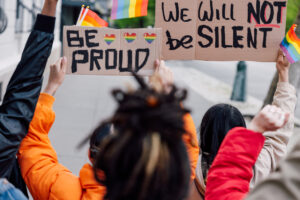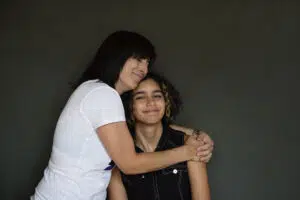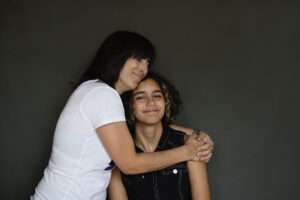 In the coming-of-age Netflix series Heartstopper, a show critically acclaimed for its authentic portrayal of modern LGBTQ+ teens, characters Charlie and Nick discover that their friendship may be something more. In one scene, Nick sends Charlie a text:
In the coming-of-age Netflix series Heartstopper, a show critically acclaimed for its authentic portrayal of modern LGBTQ+ teens, characters Charlie and Nick discover that their friendship may be something more. In one scene, Nick sends Charlie a text:
“Why is being out so complicated?” he asks.
As they explore the challenges and joy of being young and queer, they are surrounded by a supportive community – which is part of the reason critics say the show appeals so much to fans.
“Older fans love this show because it maps to universal, timeless feelings and transcends them, soothing their inner child. Everyone wishes they could have had the world [Alice] Oseman creates: a support system while they explore their sexuality, an understanding art teacher to remind them, ‘Don’t let anyone let you disappear,’ a loyal friend group, and a family that loves them for exactly who they are. Watching Heartstopper is a glimpse into what it would be like to have all of that as a teenager,” according to a VOX article.
This June Pride Month, we explore why finding a supportive community may be crucial for LGBTQ+ teen mental health – and where they might find it.
Being an LGBTQ+ Teen Today

“Yet there is a darker side. Even as they are increasingly welcomed by peers, their mental health is significantly worse than that of heterosexual young people. Many young transgender and gay people have been affected by a wave of recent Republican-led legislation questioning their identity or putting restrictions on their lives. They’re being raised by generations whose approval of and comfort with L.G.B.T.Q. identities lag their own.
Their experiences highlight a ‘paradoxical finding,’ as researchers have described it: Even as social inclusion for young L.G.B.T.Q. people has grown, large health disparities between them and their non-L.G.B.T.Q. peers have not shrunk.
‘This is what young people teach us: Change can happen as quickly as a generation,’ said Stephen T. Russell, a sociologist and professor at the University of Texas at Austin who studies adolescent development and L.G.B.T.Q. youth.
At the same time, he said, ‘the moment we’re in is so scary in terms of the mental health crisis.’”
Why Support Is Crucial
According to the 2023 U.S. National Survey on the Mental Health of LGBTQ Young People from the Trevor Project, a nonprofit organization dedicated to ending suicide among LGBTQ young people:
- “A majority of LGBTQ young people reported being verbally harassed at school because people thought they were LGBTQ.
- ”More than half of LGBTQ young people reported experiencing symptoms of depression or anxiety.
- More than half of LGBTQ young people who wanted mental health care in the past year were not able to get it.
- “41% of LGBTQ young people seriously considered attempting suicide in the past year”–and young people who are transgender, nonbinary, and/or people of color reported higher rates than their peers.
- “LGBTQ young people are not inherently prone to suicide risk because of their sexual orientation or gender identity but rather placed at higher risk because of how they are mistreated and stigmatized in society,” according to the survey website.
- When LGBTQ youth have access to spaces that affirmed their sexual orientation and gender identity, however, they reported lower rates of attempting suicide, according to the Youth.gov website.
“Strategies to improve mental health and prevent self-harming behavior and suicide include:
- providing safe and supportive environments, particularly through affirming relationships with family and peers
- enacting legislation to protect the safety of LGBTQ+ youth
- re-evaluating institutional practices that undermine positive youth development
- building community awareness and capacity to understand and address stressors that LGBT youth may experience,” according to the Youth.gov website.
Creating Safer Spaces at School

These practices may range from educating school staff on mental and behavioral health issues, creating positive youth development opportunities, and putting anti-harassment policies in place, according to the website.
“Everyone deserves to feel safe and respected in school,” according to the Trevor Project website. “The majority of young people spend many of their waking hours at school, surrounded by teachers, administrators, and peers. For LGBTQ young people, school can be a tricky place to explore who they are and how they identify, especially if they face harassment, discrimination, or a lack of resources.”
Teachers, administrators and fellow students can signal to LGBTQ+ young people and others that they are a safe person by doing the following, according to the Trevor Project website:
“Introduce yourself with your name and pronouns. Invite others to do the same.
If you’re able, decorate your space with items that signify allyship. This could be a pronoun button, a flag, or a poster of an LGBTQ film or artist.
Do not tolerate harassment or bullying in your space at all. If bullying or harassment happens, enact consequences and hold the person causing harm accountable.
Talk positively about LGBTQ people. Even in instances where it’s not appropriate to share their identity, this can show allyship. Always condemn acts of erasure if you’re able.
Integrate LGBTQ history and topics into conversation. If you’re a teacher, weave LGBTQ accomplishments into your lessons if you are able.
Never tolerate anti-LGBTQ slurs. Not as the punchline of a joke or if you’re just kidding around.
If you see someone being bullied at school, stand up for them. Show LGBTQ people that they have allies and that bullying won’t be tolerated at all. If you’re an adult, this is the time to enforce a zero tolerance policy and create consequences for harmful actions.
If the problem persists, tell a school administrator. If appropriate, let the bully know that you were the one who reported them. This prevents the LGBTQ young person from further harassment and shows that others will hold them accountable.”
Connecting to Support Online
In the absence of a supportive school community, some LGTBQ+ teens may find the support they need online.
According to a New York Times article, “Though data shows that the mental health of L.G.B.T.Q. teens is worse than that of straight teens, it can be improved by being online, said Shelley L. Craig, a Canada Research Chair in sexual and gender minority youth at the University of Toronto. Her research has found that L.G.B.T.Q. youth find two things online that are known to reduce depression and suicidal thoughts: hope, and a sense of control over their actions and environment.
They often feel safer online, she said, because they can log off or remove their profile in a way they can’t if a school bully is harassing them or a teacher or family member is saying something offensive.”
“‘The language these kids are using to describe social media in my research is: ‘It’s my home,’ ‘It’s my family,’ ‘It’s kept me alive,’’ she said. ‘We’ve found it has built L.G.B.T.Q. youth’s resilience, and given them hope,’” according to the article.
Finding Acceptance at Home

“Parents and schools play big roles and can do specific things to support L.G.B.T.Q. youth, researchers say. Studies find that family acceptance is among the most important protective factors, something that teenagers also said in interviews.
‘Accepting peers is important, but it is not the most important component of the mental health crisis that L.G.B.T.Q. youth are experiencing,’ said Shelley L. Craig, the Canada Research Chair in sexual and gender minority youth at the University of Toronto. ‘It’s family rejection.’”
PFLAG is an organization dedicated to supporting, educating and advocating for LGBTQ+ people and those who love them. Tips for supporting your LGBTQ child or loved one as they are coming out, according to the PFLAG website, include the following:
- “Lead with love. For some, this will be the natural response. For others, long-held beliefs may get in the way of being able to respond positively and supportively. As best as you can, however, remember this: No matter how easy or difficult learning about your child’s sexual orientation or gender identity is for you, it probably was difficult for them to come out to you. And, while saying ‘I love you’ is one obvious way to express your love for your child, if you find yourself at a loss for words, as many of us do sometimes, a hug can speak volumes.
- Listen with intention. Give your child ample opportunity to open up and share their thoughts and feelings. Whether they want to talk about their hopes for the future, or a situation that happened in school or at work that day, the prospect for open discussion is endless. If you have a sense that your loved one might want to talk, but isn’t doing so on their own, a gentle open-ended question, such as, ‘How did things go at school/work/church’ today, can open the door to dialogue.
- Show subtle support. If overt support is a stretch at first, remember that subtle support can also make a difference. Whether it’s speaking positively about an LGBTQ person you know, or a character from a movie or television show; reflecting out loud about gender or sexuality issues surfacing in the news; or openly reading and sharing new learning about gender or sexual diversity, these small hints let kids know that you are supportive and understanding.
- Learn the terms. What is sexual orientation? What does it mean to be ‘bisexual’? Learning the language is a great way to start having important and sometimes challenging conversations. Of course, like every other human on the planet, you will likely make a few mistakes along the way—and that’s okay! Own it, apologize, move on, and work to do better next time. Visit pflag.org/glossary to get started.”
Another thing you can do is make sure your loved one is getting mental health help if they need it. If the person is experiencing mental health issues, help them seek out a clinician who is supportive and experienced counseling in this area. Be sure to choose one who is helping their LGBTQ+ patients feel more welcome in their practice. And if the clinician treatment plan includes medication, it may be helpful to talk to the clinician about the GeneSight test, which may be used to help inform on medication selection and dosing based on a person’s genetics.
Some teens have used the show Heartstopper to start the coming out conversation with their parents, including 18-year-old Esme Calder. They hoped that the scene where the character Nick comes out to his mom would inspire a positive response in their own parents as well, according to the VOX article.
“In the scene, Nick’s mom’s reaction is sweet, kind, and understanding, as she says, ‘Thank you for telling me … I’m sorry if I ever made you feel like you couldn’t tell me that.’ No negativity. No awkwardness. Only love. This reaction is one of the reasons Esme used the scene to come out. If their parents didn’t know how to react or what to say, they’d have a model of how to behave,” according to the article.
“‘In a lot of media, when there’s a scene of a queer character coming out, a lot of the time it’s shown to go really poorly. And obviously that can happen,’ Esme said. ‘But it’s equally important to show that it can go well and it can be a really beautiful moment.’”





